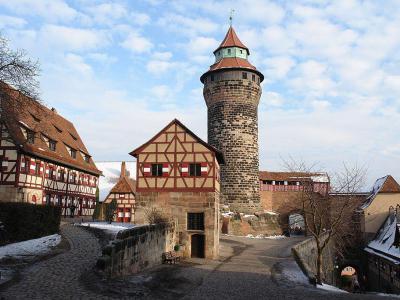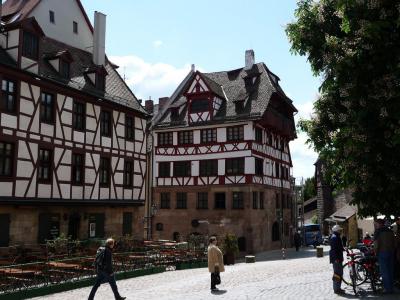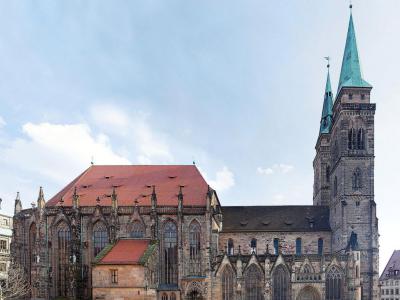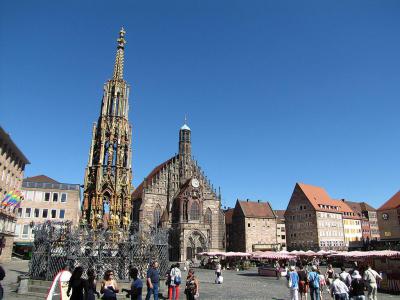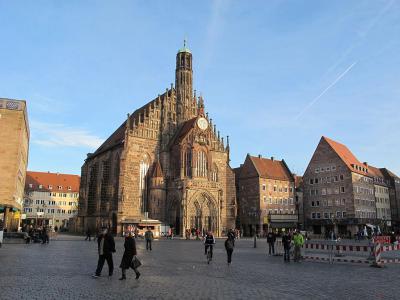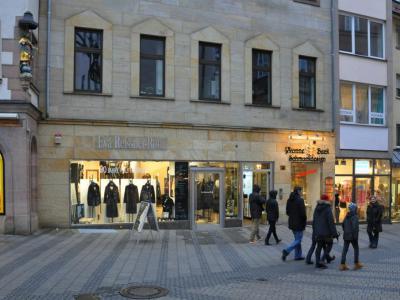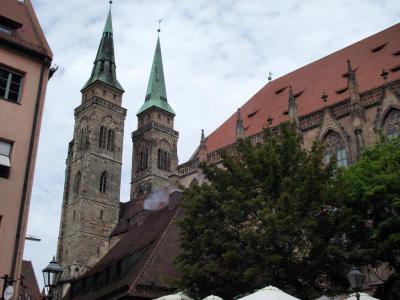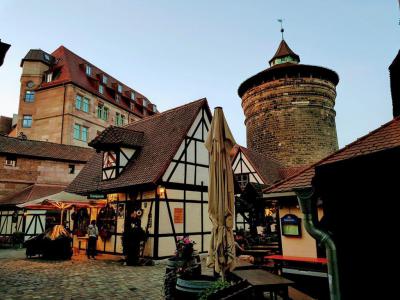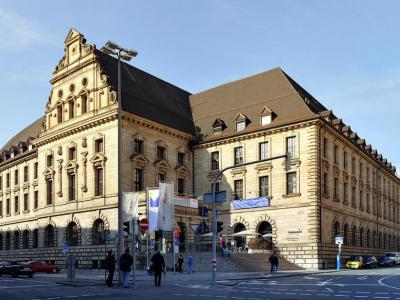
Nuremberg Introduction Walking Tour (Self Guided), Nuremberg
The most "German" of all cities in Germany, Nuremberg has witnessed many historic events in its lifetime. Sadly, the first thing immediately associated with Nuremberg is the rise of the Third Reich, the Nazi rallies, and the postwar trials over the Nazi leaders. Indeed, the city was favored by Hitler, who planned to build here a grandiose architectural complex for his party.
Nonetheless, prior to WWII, Nuremberg had given the world its famous sausages and gingerbread, and even earned some rather joyful, informal titles like the "treasury of Germany" and the "city of toys”.
Most versions as to the origin of its name suggest the word "nor", the Latin for rock, referring to the castle built on the rocky outcrop (Nuoin-berg) in the early 11th century, around which servants, artisans and merchants began to settle and thus laid foundation for the future city. The first documented mention of Nuremberg, as the location of the Imperial Castle, dates back to 1050.
Thenceforth until 1571 the city expanded and rose dramatically in importance due to its location on key trade-routes on the Pegnitz River. The largest growth of Nuremberg occurred in the 14th century when it was appointed to hold the first Imperial Diet by the newly elected kings of Germany. The Frauenkirche, built between 1352 and 1362 in Hauptmarkt, is where the Imperial Court worshiped during their stay.
The cultural flowering of Nuremberg in the 15th-16th centuries made it the center of the German Renaissance. Symbolic in this respect is Nuremberg's being the birthplace of the great German artist, Albrecht Dürer, who lived here from 1509 until his death in 1528, and whose house is now a museum.
Previously a free imperial city, Nuremberg officially became part of Bavaria in 1806. Later in the 19th century it emerged as an industrial hub, and grew further in significance during the Nazi era, becoming an important site for military production during World War II. Unfortunately, 90% of the city was destroyed in 1945; but fortunately, after the war, much of the medieval Old Town was rebuilt.
These days, Bavaria's second largest city after Munich – although Franconian in essence, with a distinctive vibe and dialect – Nuremberg is a popular tourist destination, visited annually by up to two million guests. If you are in Nuremberg, make some time to explore its notable attractions with the help of our introductory walk.
Nonetheless, prior to WWII, Nuremberg had given the world its famous sausages and gingerbread, and even earned some rather joyful, informal titles like the "treasury of Germany" and the "city of toys”.
Most versions as to the origin of its name suggest the word "nor", the Latin for rock, referring to the castle built on the rocky outcrop (Nuoin-berg) in the early 11th century, around which servants, artisans and merchants began to settle and thus laid foundation for the future city. The first documented mention of Nuremberg, as the location of the Imperial Castle, dates back to 1050.
Thenceforth until 1571 the city expanded and rose dramatically in importance due to its location on key trade-routes on the Pegnitz River. The largest growth of Nuremberg occurred in the 14th century when it was appointed to hold the first Imperial Diet by the newly elected kings of Germany. The Frauenkirche, built between 1352 and 1362 in Hauptmarkt, is where the Imperial Court worshiped during their stay.
The cultural flowering of Nuremberg in the 15th-16th centuries made it the center of the German Renaissance. Symbolic in this respect is Nuremberg's being the birthplace of the great German artist, Albrecht Dürer, who lived here from 1509 until his death in 1528, and whose house is now a museum.
Previously a free imperial city, Nuremberg officially became part of Bavaria in 1806. Later in the 19th century it emerged as an industrial hub, and grew further in significance during the Nazi era, becoming an important site for military production during World War II. Unfortunately, 90% of the city was destroyed in 1945; but fortunately, after the war, much of the medieval Old Town was rebuilt.
These days, Bavaria's second largest city after Munich – although Franconian in essence, with a distinctive vibe and dialect – Nuremberg is a popular tourist destination, visited annually by up to two million guests. If you are in Nuremberg, make some time to explore its notable attractions with the help of our introductory walk.
How it works: Download the app "GPSmyCity: Walks in 1K+ Cities" from Apple App Store or Google Play Store to your mobile phone or tablet. The app turns your mobile device into a personal tour guide and its built-in GPS navigation functions guide you from one tour stop to next. The app works offline, so no data plan is needed when traveling abroad.
Nuremberg Introduction Walking Tour Map
Guide Name: Nuremberg Introduction Walking Tour
Guide Location: Germany » Nuremberg (See other walking tours in Nuremberg)
Guide Type: Self-guided Walking Tour (Sightseeing)
# of Attractions: 9
Tour Duration: 2 Hour(s)
Travel Distance: 2.8 Km or 1.7 Miles
Author: Ella
Sight(s) Featured in This Guide:
Guide Location: Germany » Nuremberg (See other walking tours in Nuremberg)
Guide Type: Self-guided Walking Tour (Sightseeing)
# of Attractions: 9
Tour Duration: 2 Hour(s)
Travel Distance: 2.8 Km or 1.7 Miles
Author: Ella
Sight(s) Featured in This Guide:
- Nuremberg Castle
- Albrecht-Durer-Haus (Albrecht Durer House Museum)
- St. Sebaldus Church
- Hauptmarkt (Main Market Square)
- Frauenkirche (Church of Our Lady)
- Kaiserstraße (Kaiser Street)
- St. Lawrence's Church
- Handwerkerhof (Crafts Yard)
- Nuremberg Transport Museum
1) Nuremberg Castle (must see)
Nuremberg Castle is one of the most famous and magnificent castles in Germany. Every Holy Roman Emperor between 1050 and 1571 resided part-time at the castle. Essential administrative functions were carried out at the castle. Charles IV enacted the Golden Bull at the castle in 1356. This decree required that newly elected German kings would hold their first general assembly at Nuremberg.
The Sinwell Tower was built for defensive purposes in the 13th century. Sinwell means extremely round in Middle High German. Visitors can climb the tower's wooden spiral staircase to an observation platform. Photos of Nuremberg immediately after WWII are displayed at the top of the tower. You can see how much damage Nuremberg had and how meticulous the rebuild has been.
Visitors must be accompanied by a guide to see the Deep Well. This site is one of the highlights of the castle. The well is nearly 50 meters (164 feet) deep and was an essential water supply for the castle. The house covering the well was built in 1563.
The Double Chapel is another exquisite site. This Romanesque Imperial Chapel dates to the 13th century. The chapel features an emperor's gallery, which allowed the emperor to remain separate from the other worshippers.
The Imperial Hall was used as a dining hall and for festivities. Today, visitors can find Holy Roman Empire exhibits. The Emperor's Living Room features colorfully painted ceiling squares. The wall panels are decored with gold and date back to the 15th century.
The Corner Chamber features gorgeous art and gifts given to the Imperial Crown. Visitors will also find an impressive wooden model of the city, as well as the jeweled Imperial Crown. Visitors will find weapons from the 13th to 19th centuries in the Imperial Castle Museum.
After touring the castle, don't miss the Castle Garden with its beautiful flower beds.
Why You Should Visit:
Nuremberg Castle is steeped in history and has been beautifully restored. Visitors can walk the cobblestone paths, immerse themselves in the castle's history, and admire the stunning architecture and art displays.
Tips:
A combination ticket provides access to Nuremberg Castle, the Double Chapel, the Imperial Castle Museum, the Deep Well, and the Sinwell Tower. Guests can only visit the Deep Well with a guide. Audio guides for the castle are available in several languages.
The Sinwell Tower was built for defensive purposes in the 13th century. Sinwell means extremely round in Middle High German. Visitors can climb the tower's wooden spiral staircase to an observation platform. Photos of Nuremberg immediately after WWII are displayed at the top of the tower. You can see how much damage Nuremberg had and how meticulous the rebuild has been.
Visitors must be accompanied by a guide to see the Deep Well. This site is one of the highlights of the castle. The well is nearly 50 meters (164 feet) deep and was an essential water supply for the castle. The house covering the well was built in 1563.
The Double Chapel is another exquisite site. This Romanesque Imperial Chapel dates to the 13th century. The chapel features an emperor's gallery, which allowed the emperor to remain separate from the other worshippers.
The Imperial Hall was used as a dining hall and for festivities. Today, visitors can find Holy Roman Empire exhibits. The Emperor's Living Room features colorfully painted ceiling squares. The wall panels are decored with gold and date back to the 15th century.
The Corner Chamber features gorgeous art and gifts given to the Imperial Crown. Visitors will also find an impressive wooden model of the city, as well as the jeweled Imperial Crown. Visitors will find weapons from the 13th to 19th centuries in the Imperial Castle Museum.
After touring the castle, don't miss the Castle Garden with its beautiful flower beds.
Why You Should Visit:
Nuremberg Castle is steeped in history and has been beautifully restored. Visitors can walk the cobblestone paths, immerse themselves in the castle's history, and admire the stunning architecture and art displays.
Tips:
A combination ticket provides access to Nuremberg Castle, the Double Chapel, the Imperial Castle Museum, the Deep Well, and the Sinwell Tower. Guests can only visit the Deep Well with a guide. Audio guides for the castle are available in several languages.
2) Albrecht-Durer-Haus (Albrecht Durer House Museum)
The home of German Renaissance painter and printmaker Albrecht Durer from 1509 to his death in 1528 lies in the extreme north-west of Nuremberg's Altstadt, near the Kaiserburg section of the Nuremberg Castle and the Tiergärtnertor of Nuremberg's city walls.
The house was built around 1420. It has five stories; the bottom two have sandstone walls, while the upper stories are timber-framed; the entire structure is topped by a half-hip roof. In 1501, it was purchased by Bernhard Walther, a merchant and prominent astronomer. Walter remodeled the house, adding small windows to the roof so that it could function as an observatory. Walther died in 1504, and Durer purchased the house five years later.
Since 1871 the Albrecht-Durer-Haus has been a museum dedicated to Durer's life and work. It was heavily remodeled sometime in the 1890s, with the large dormer on the north-facing roof being the largest addition. In October 1944, it took significant damage from Allied bombing. It was rebuilt by 1949 but did not reopen as a museum until 1971, Durer's 500th birthday.
The museum features installations of period furnishings, a re-creation of Dürer's workshop in which visitors can view demonstrations of printmaking techniques, and rotating exhibitions of drawings and prints by Dürer from the City of Nuremberg's Graphic Collection. Visitors can also receive a guided tour of the house from an actress playing Agnes Durer, the wife of the printmaker.
Why You Should Visit:
The amazing stories about the building and Durer's life are fascinating (eg. petty bureaucrats and 'facilities').
The house was built around 1420. It has five stories; the bottom two have sandstone walls, while the upper stories are timber-framed; the entire structure is topped by a half-hip roof. In 1501, it was purchased by Bernhard Walther, a merchant and prominent astronomer. Walter remodeled the house, adding small windows to the roof so that it could function as an observatory. Walther died in 1504, and Durer purchased the house five years later.
Since 1871 the Albrecht-Durer-Haus has been a museum dedicated to Durer's life and work. It was heavily remodeled sometime in the 1890s, with the large dormer on the north-facing roof being the largest addition. In October 1944, it took significant damage from Allied bombing. It was rebuilt by 1949 but did not reopen as a museum until 1971, Durer's 500th birthday.
The museum features installations of period furnishings, a re-creation of Dürer's workshop in which visitors can view demonstrations of printmaking techniques, and rotating exhibitions of drawings and prints by Dürer from the City of Nuremberg's Graphic Collection. Visitors can also receive a guided tour of the house from an actress playing Agnes Durer, the wife of the printmaker.
Why You Should Visit:
The amazing stories about the building and Durer's life are fascinating (eg. petty bureaucrats and 'facilities').
3) St. Sebaldus Church
Located at the Albrecht-Dürer-Platz, in front of the old city hall, the St. Sebaldus Church takes its name from Sebaldus, an 8th-century hermit and missionary and patron saint of Nuremberg. It was originally built as a Romanesque basilica with two choirs in the 1230s with the two towers having been added in the 15th century. In the middle 17th century, galleries were also added and the interior was remodeled in Baroque fashion.
The church suffered serious damage during World War II and was subsequently reconstructed. Some of the old interior did survive, including the Shrine of St. Sebaldus, works by Veit Stoss and the stained glass windows. The church had an organ by the 14th century, and another by the 15th.
The main organ had been built in 1440–41 by Heinrich Traxdorf, who also built two small organs for Nuremberg's Frauenkirche. Until its destruction in the 20th century it was one of the oldest playable organs in the world, and all the more notable because Traxdorf was one of the first organ builders to depart from the Gothic Blockwerk organ by dividing the windchests and separating the front stops into Flute (Principal) and Octave (see pipe organ).
Why You Should Visit:
Great atmosphere that puts you back into medieval times! Also in a beautiful area, just off the northwest corner of the Main Market.
Tip:
Admission is free at the public church tours, although donations are appreciated. For tower tours, the fee is €5 (children €2).
Several times a year, the church and tower are open until late at night, as part of the "Blue Night" festivities in Nuremberg.
The church suffered serious damage during World War II and was subsequently reconstructed. Some of the old interior did survive, including the Shrine of St. Sebaldus, works by Veit Stoss and the stained glass windows. The church had an organ by the 14th century, and another by the 15th.
The main organ had been built in 1440–41 by Heinrich Traxdorf, who also built two small organs for Nuremberg's Frauenkirche. Until its destruction in the 20th century it was one of the oldest playable organs in the world, and all the more notable because Traxdorf was one of the first organ builders to depart from the Gothic Blockwerk organ by dividing the windchests and separating the front stops into Flute (Principal) and Octave (see pipe organ).
Why You Should Visit:
Great atmosphere that puts you back into medieval times! Also in a beautiful area, just off the northwest corner of the Main Market.
Tip:
Admission is free at the public church tours, although donations are appreciated. For tower tours, the fee is €5 (children €2).
Several times a year, the church and tower are open until late at night, as part of the "Blue Night" festivities in Nuremberg.
Sight description based on Wikipedia.
4) Hauptmarkt (Main Market Square) (must see)
The Main Market Square has been the center of activity and commerce in Nuremberg since ancient times. The celebrated marketplace runs Monday through Saturday. Visitors and locals love to shop the plentiful fruits and vegetables, fresh bread, treats, ready-to-eat meals, and fresh flowers.
The Main Market Square features several iconic landmarks. The Beautiful Fountain was completed in 1396 and is a Gothic masterpiece. It stands an impressive 19 meters (62 feet) tall.
Forty ornate figures decorate the fountain. The figures represent important icons in the Holy Roman Empire such as philosophy, liberal arts, the four Church Fathers, the four Evangelists, the seven Prince-electors, the Nine Worthies, Moses, and the seven Prophets. Legend tells of good luck brought to visitors who spin the two brass rings on the fence.
Another impressive landmark on the square is The Church of Our Lady. This Gothic church was built in the 14th century and features a beautiful facade.
The Main Market Square hosts various festivals and events throughout the year. Popular events include the Nuremberg Flea Market, the Nuremberg Old Town Festival, and the Christmas market.
The Main Market Square features several iconic landmarks. The Beautiful Fountain was completed in 1396 and is a Gothic masterpiece. It stands an impressive 19 meters (62 feet) tall.
Forty ornate figures decorate the fountain. The figures represent important icons in the Holy Roman Empire such as philosophy, liberal arts, the four Church Fathers, the four Evangelists, the seven Prince-electors, the Nine Worthies, Moses, and the seven Prophets. Legend tells of good luck brought to visitors who spin the two brass rings on the fence.
Another impressive landmark on the square is The Church of Our Lady. This Gothic church was built in the 14th century and features a beautiful facade.
The Main Market Square hosts various festivals and events throughout the year. Popular events include the Nuremberg Flea Market, the Nuremberg Old Town Festival, and the Christmas market.
5) Frauenkirche (Church of Our Lady) (must see)
The Frauenkirche ("Church of Our Lady") stands on the eastern side of the main market in Nuremberg. An example of brick Gothic architecture, it was built on the initiative of Charles IV, Holy Roman Emperor between 1352 and 1362. The church contains many sculptures, some of them heavily restored. Numerous works of art from the Middle Ages are kept in the church, such as the so-called Tucher Altar (c. 1440, originally the high altar of the Augustinian church of St. Vitus), and two monuments by Adam Kraft (c. 1498).
The church was built in place of the former Jewish synagogue, which was destroyed during the pogrom of 1349 (which followed an outbreak of Black Death). Charles IV wanted to use the Frauenkirche for imperial ceremonies, which is reflected in the porch with the balcony, and in the fact that the church is relatively unadorned except for the coats of arms of the Holy Roman Empire, the seven Electors, the town of Nuremberg, and the city of Rome, where the Holy Roman Emperors were crowned.
One of the most notable features of the church is the Männleinlaufen, a mechanical clock that commemorates the Golden Bull of 1356. The clock was installed in the church between 1506 and 1509. The Holy Roman Emperor is shown seated with the prince-electors surrounding him.
Why You Should Visit:
Photogenic, easy to find, with some lovely stained glass windows and a late Gothic altarpiece from 1445 inside. On a very cold, rainy day it also provides a place of refuge, warmth and peace.
At its front door are the open-air stalls, selling lots of fresh fruit, vegetables, and gingerbread. Going up the steep steps to the viewing area overlooking the market is quite an experience.
Tip:
Try to visit at noontime when the clock mechanism is activated. After the bell tolls the hour, you can watch an animated procession with figures depicting the electors of the Holy Roman Empire paying homage to the Emperor. It's a brief but entertaining show if in the area.
The church was built in place of the former Jewish synagogue, which was destroyed during the pogrom of 1349 (which followed an outbreak of Black Death). Charles IV wanted to use the Frauenkirche for imperial ceremonies, which is reflected in the porch with the balcony, and in the fact that the church is relatively unadorned except for the coats of arms of the Holy Roman Empire, the seven Electors, the town of Nuremberg, and the city of Rome, where the Holy Roman Emperors were crowned.
One of the most notable features of the church is the Männleinlaufen, a mechanical clock that commemorates the Golden Bull of 1356. The clock was installed in the church between 1506 and 1509. The Holy Roman Emperor is shown seated with the prince-electors surrounding him.
Why You Should Visit:
Photogenic, easy to find, with some lovely stained glass windows and a late Gothic altarpiece from 1445 inside. On a very cold, rainy day it also provides a place of refuge, warmth and peace.
At its front door are the open-air stalls, selling lots of fresh fruit, vegetables, and gingerbread. Going up the steep steps to the viewing area overlooking the market is quite an experience.
Tip:
Try to visit at noontime when the clock mechanism is activated. After the bell tolls the hour, you can watch an animated procession with figures depicting the electors of the Holy Roman Empire paying homage to the Emperor. It's a brief but entertaining show if in the area.
Sight description based on Wikipedia.
6) Kaiserstraße (Kaiser Street)
Kaiser Street is the premier shopping street in Nuremberg. Some of the shops on Kaiser Street date back to 1810. Visitors can walk the street for a mile and find a luxurious mix of fabulous goods. Shop for various leatherwork goods, exquisite fabrics, fine shoes, and home design goods.
International designer brands are front and center along this high-end shopping street. You'll find brands such as Dolce & Gabbana, Gucci, and Prada. Visitors can find a diverse array of artworks to tempt them, from classical paintings to modern artworks. Shoppers are also treated to gorgeous displays of elegant jewelry.
Shop for the latest fashions and check out small, unique boutiques. Finally, the street has many delightful cafes to tempt you and offer a break from shopping.
International designer brands are front and center along this high-end shopping street. You'll find brands such as Dolce & Gabbana, Gucci, and Prada. Visitors can find a diverse array of artworks to tempt them, from classical paintings to modern artworks. Shoppers are also treated to gorgeous displays of elegant jewelry.
Shop for the latest fashions and check out small, unique boutiques. Finally, the street has many delightful cafes to tempt you and offer a break from shopping.
7) St. Lawrence's Church (must see)
Dedicated to one of the most venerated saints of the Roman Catholic Church, this church was badly damaged during World War II and later restored, now standing as one of the most prominent among the Evangelical Lutheran churches in Bavaria. More notably, the church is rich in 14th and 15th Century altarpieces, the earliest dating from 1316.
The church’s Gothic choir called "St. Laurentius" was designed by medieval master mason Konrad Roriczer in 1445. There are also notable sculptures, including the famous statue of the "beautiful Madonna" – unusually portrayed smiling – from around 1280. Most striking is a stunning stone tabernacle, (built in 1493-6) the carvings of which depict the Passion of Christ. It is surmounted by a veritable explosion of pinnacles which soar 20 meters to the springing of the vaulting. As if this were not enough, the church has an exceptional array of medieval stained glass, mostly from the 15th century.
The building and furnishing of the church were cared of by the city council and by wealthy citizens. This is probably the reason why the art treasures of St. Lawrence were spared during the iconoclasm during the Reformation period. Despite St. Lawrence's being one of the first churches in Germany to be Lutheran (1525), the wealthy citizens of Nuremberg wanted to preserve the memory of their ancestors and refused the removal of the donated works of art.
The west facade is richly articulated, reflecting the wealth of the Nuremberg citizens. The facade is dominated by the two towers, mirroring St. Sebald and indirectly Bamberg Cathedral with a sharp towering West portal doorway, and an indented rose window 9 meters in diameter.
The church’s Gothic choir called "St. Laurentius" was designed by medieval master mason Konrad Roriczer in 1445. There are also notable sculptures, including the famous statue of the "beautiful Madonna" – unusually portrayed smiling – from around 1280. Most striking is a stunning stone tabernacle, (built in 1493-6) the carvings of which depict the Passion of Christ. It is surmounted by a veritable explosion of pinnacles which soar 20 meters to the springing of the vaulting. As if this were not enough, the church has an exceptional array of medieval stained glass, mostly from the 15th century.
The building and furnishing of the church were cared of by the city council and by wealthy citizens. This is probably the reason why the art treasures of St. Lawrence were spared during the iconoclasm during the Reformation period. Despite St. Lawrence's being one of the first churches in Germany to be Lutheran (1525), the wealthy citizens of Nuremberg wanted to preserve the memory of their ancestors and refused the removal of the donated works of art.
The west facade is richly articulated, reflecting the wealth of the Nuremberg citizens. The facade is dominated by the two towers, mirroring St. Sebald and indirectly Bamberg Cathedral with a sharp towering West portal doorway, and an indented rose window 9 meters in diameter.
Sight description based on Wikipedia.
8) Handwerkerhof (Crafts Yard)
The Crafts Yard opened in 1971 and features traditional crafts. Visitors and locals can watch craft creators at work using traditional tools to create handmade goods. The Crafts Yard invited visitors to go back to a time period when goods were painstakingly made by hand and were treasured possessions, often passed from generation to generation.
The Crafts Yard is located in the Free Imperial City's former armory. Surrounded by the ancient town wall, the Crafts Yard features narrow walkways, half-timbered houses, and cozy inns.
As you stroll through the yard, you can walk tinsmiths and woodworkers making toys and goldsmiths creating art. Crafters create traditional goods such as model railways, miniature doll prams, and handmade figurines.
The yard hosts exhibitions showcasing crafting traditions such as bookbinding and gingerbread making.
Visitors can watch the artists at work as well as purchase these unique items. Bring home beautifully handmade souvenirs and gifts.
The Crafts Yard also has delightful cafes, restaurants, and bars sprinkled about the craft shops.
The Crafts Yard is located in the Free Imperial City's former armory. Surrounded by the ancient town wall, the Crafts Yard features narrow walkways, half-timbered houses, and cozy inns.
As you stroll through the yard, you can walk tinsmiths and woodworkers making toys and goldsmiths creating art. Crafters create traditional goods such as model railways, miniature doll prams, and handmade figurines.
The yard hosts exhibitions showcasing crafting traditions such as bookbinding and gingerbread making.
Visitors can watch the artists at work as well as purchase these unique items. Bring home beautifully handmade souvenirs and gifts.
The Crafts Yard also has delightful cafes, restaurants, and bars sprinkled about the craft shops.
9) Nuremberg Transport Museum (must see)
This museum was originally opened in 1882 in another location. The present building was constructed in 1925. The museum covers 200 years of railway history.
In 1835, the first railway track in Germany was laid between Nuremberg and Furth. The first locomotive, the Adler, was imported from England. The railway quickly impacted towns and cities and opened the door to the industrial age. Unfortunately, that same rail network played a horrible part in transporting millions of Jews to death camps during World War II.
Exhibits include various historical railway vehicles and 160 models, a model railway, and a library with extensive titles on railways.
Notable historic vehicles on display include parts of Bavarian King Ludwig II's royal train. Visitors can see Germany's oldest preserved steam locomotive from 1853. In addition, an original 1829 coal wagon is on display. This is the oldest railway vehicle on exhibit on the continent.
The 1:10 scale models take up 1,000 square meters (10,000 square feet). The first model was created in 1882, and all the models are exquisitely detailed. Visitors can walk through a train tunnel, go through a level crossing, view working signals, and watch models with sound and lights. Attend the 10-minute demonstration of a typical railway. A model railway is used to show 5,000 relays that show railway operation.
Visitors will be inspired by the ICE-4 model, the next-generation high-speed train.
In 1835, the first railway track in Germany was laid between Nuremberg and Furth. The first locomotive, the Adler, was imported from England. The railway quickly impacted towns and cities and opened the door to the industrial age. Unfortunately, that same rail network played a horrible part in transporting millions of Jews to death camps during World War II.
Exhibits include various historical railway vehicles and 160 models, a model railway, and a library with extensive titles on railways.
Notable historic vehicles on display include parts of Bavarian King Ludwig II's royal train. Visitors can see Germany's oldest preserved steam locomotive from 1853. In addition, an original 1829 coal wagon is on display. This is the oldest railway vehicle on exhibit on the continent.
The 1:10 scale models take up 1,000 square meters (10,000 square feet). The first model was created in 1882, and all the models are exquisitely detailed. Visitors can walk through a train tunnel, go through a level crossing, view working signals, and watch models with sound and lights. Attend the 10-minute demonstration of a typical railway. A model railway is used to show 5,000 relays that show railway operation.
Visitors will be inspired by the ICE-4 model, the next-generation high-speed train.
Walking Tours in Nuremberg, Germany
Create Your Own Walk in Nuremberg
Creating your own self-guided walk in Nuremberg is easy and fun. Choose the city attractions that you want to see and a walk route map will be created just for you. You can even set your hotel as the start point of the walk.
Nuremberg Old Town Walking Tour
The historical center of Nuremberg, Old Town (German: Altstadt) is easily differentiated from other parts of the city. Divided in two by the Pegnitz River, the district represents a complex architectural ensemble with a maze of historical lanes (e.g. Weissgerbergasse) packed with half-timber houses, linked by centuries-old bridges, such as Maxbrücke, and set against the picturesque backdrops of... view more
Tour Duration: 3 Hour(s)
Travel Distance: 3.8 Km or 2.4 Miles
Tour Duration: 3 Hour(s)
Travel Distance: 3.8 Km or 2.4 Miles
Hitler's Nuremberg Tour
Despite Nuremberg's storybook appearance, the city's not so distant past is rather dark. Back in 1933, amid the rise of the Third Reich, the Nazis worked really hard to leave their stamp on the city, prettifying it and renovating the architecture in a bid to accommodate their massive rallies and bombastic military parades.
In fact, no other city in Germany is more intertwined with the... view more
Tour Duration: 2 Hour(s)
Travel Distance: 4.9 Km or 3 Miles
In fact, no other city in Germany is more intertwined with the... view more
Tour Duration: 2 Hour(s)
Travel Distance: 4.9 Km or 3 Miles
The Most Popular Cities
/ view all
